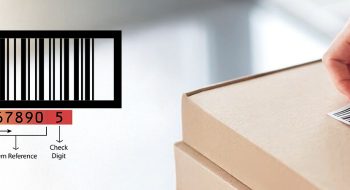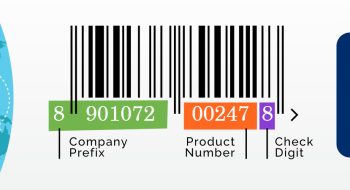This blog gives an overview of the importance of barcodes in e-Commerce marketplace operations and supply chain processes.
Content
- Introduction
- Supply Chain Management
- Supplier Relationship Management
- Fulfilment by Amazon
- Fulfilment by Merchant
- Internal Supply Chain Management
- Customer Relationship Management
- Conclusion
Introduction
Amazon is a major e-commerce marketplace in India. Its operating revenue from e-commerce sales in India was Rs162 billion in March 2021. As per a report published by Inc42 in 2021, it has more than 850 thousand sellers selling 50 million+ products to 100 million+ users in India. This blog focusses on how barcodes help Amazon in its supply chain operations.
Supply Chain Management
As an e-commerce marketplace, Amazon has a very complex supply chain. It has to get the products from its vendors, manage warehouse operations, and supply to the customers when they order the product.
The entire supply chain management can be divided into three domains viz. Supplier Relationship Management, Internal Supply Chain Management, and Customer Relationship Management.
Supplier Relationship Management:
Supplier Relationship Management (SRM) is an approach to systematically access the contribution of suppliers in the business. It helps to improve business processes by coordination and evaluation.
Barcodes make the order receiving process accurate, scalable, fast, and traceable, thereby helping Amazon Marketplace manage supplier relationships.
There are two modes of listing products on Amazon, viz. — Fulfillment by Amazon (FBA) and Fulfillment by Merchant (FBM).
Fulfillment by Amazon (FBA)
FBA is the business model that helps suppliers and business owners use Amazon’s vast logistics network spread across India to deliver products to customers.
Sellers list their products on Amazon and then ship them to Amazon fulfillment centers for further processing.
At the Amazon fulfillment center, the following inbound processes take place.
- Each product is received by the inbound team
- Each product has a unique barcode called Amazon Standard Identification Number (ASIN), which is linked with GTIN
- The ASIN is scanned and the product is stowed in mobile storage pods
- These storage pods are moved from one location to another using automated robots
- Details of the product, including quantity and which storage pod the product is stored in, is recorded in Amazon’s inventory system.
When a consumer orders a product the following outbound processes take place.
- The Amazon inventory system checks and locates the storage pod where the item is stored
- The storage pod is moved by robots to the pick station
- An associate picks the item and places it in a tray which is transported to packing station via conveyer belts
- The items are packed, and a barcode is placed on the package
- The package is sent via conveyer belt to a SLAM (Scan, Label, Apply and Manifest) station
- The system scans the barcode, and prints and applies the consumer address on the package.
- The package is then shipped to the consumer.
Fulfilment by Merchant (FBM)
In FBM, the merchant is responsible for handling and shipping products. While Amazon acts as a platform to sell the product, the seller directly ships them to the final customer.
Amazon encourages third-party sellers to use Global Trade Identification Numbers (GTIN) to uniquely identify the products when they want to list the products on Amazon. The GTIN is a globally unique identification number for a product, issued by GS1 organizations across the globe. The sellers can use GTIN (EAN Product Codes) to identify the products and manage the master data for all their products. They can use DataKart to easily share product attributes with Amazon for listing on the platform or pull the data in required format and share it externally.
Internal Supply Chain Management:
Internal supply chain management refers to the functions such as sales, distribution, inventory keeping, and warehouse management, etc.
Amazon uses ASIN to improve efficiency of its supply chain. This enables
- Data entry in the inventory system
- Reconciliation of physical and system inventory
- Enabling automation in warehouses
- Barcodes are scanned while storing and retrieving items
- Barcode scans are used to move items on correct conveyer belts
- Package barcodes are scanned for labelling of packages for shipment
- Reduce processing time
- Improved data accuracy
Customer Relationship Management:
Customer Relationship Management (CRM) is used to manage a company’s relationships and interactions with current and future customers to improve business relations.
The consumers get a better shopping experience while browsing on e-commerce sites as they are able to easily view products which are similar to their previous searches and purchases. This improves consumer loyalty for the company and generates positive word of mouth which results in higher profitability.
The use of ASIN facilitates better consumer relationship management.
- Marketplaces can tailor display of product categories, based on prior order/search history of user
- A consumer can scan the product barcode (GTIN) on the product to directly order the item from the Amazon app
- ASIN and barcodes can be used for hassle-free tracking of orders
- ASIN can be used as product identifiers while interacting with consumer care team
Conclusion
Amazon has showcased how unique barcodes encoded with unique product identification facilitate world-class warehousing solutions, inventory management, product visibility, effortless product tracing, and efficient supply chain management. Other marketplaces are also adopting barcodes (GTINs) to improve their operations.
DISCLAIMER: The trade names, logos, trademarks, or similar Intellectual Properties (IPs) shown or depicted in the publication of this article/whitepaper/presentation/work / literary work, remain the properties of the respective owners/beneficiaries. The inclusion of such trade names, logos, trademarks, or IPs does not denote ownership or claim, or allocation of any rights to GS1 India. These references have been made entirely for informational purposes with a view to describe and provide illustrative references to the products and/or services offered by GS1 India. GS1 India respects the IP-related rights of each and every IP owner and is committed to complying with all relevant laws and regulations. Accordingly, the use of such trade names, logos, trademarks, or similar IPs, is being only done under the principles of ‘fair use’. Any concern or objection to the information and reference usage of any trade name, logo, trademark, or IP; can be raised with the legal department of GS1 India at legal@gs1india.org









